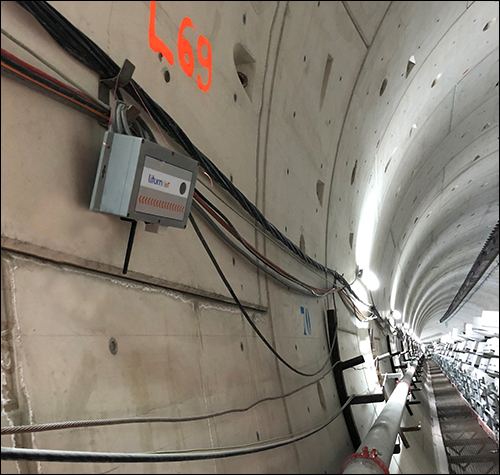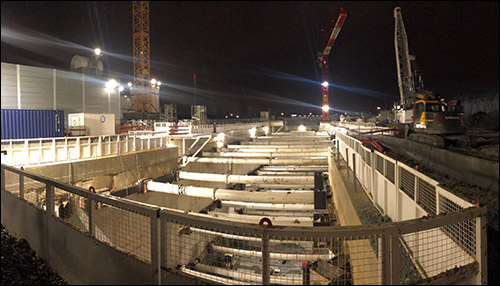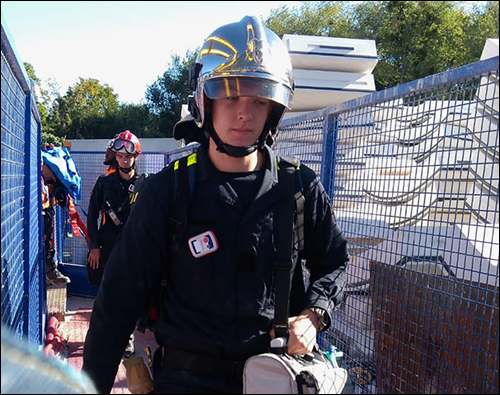Paris Metro is tracking the security of hundreds of construction workers in tunnels as it expands its underground rail line. The current tunnel project was launched in March 2018, with another phase beginning in March of this year.
The safety system that accompanies the construction project consists of UWB RFID-based sensors worn by personnel, which are read by a network of receivers, as well as sensors mounted throughout the tunnel for emergency reporting. The solution is provided by FS Tunnel, using UWB RFID technology from Litum IoT.
The project, known as the Grand Paris Express, commenced in 2017, is overseen by public enterprise Société du Grand Paris and consists of multiple new rapid-transit lines in the Paris region. The latest rail line comprises five stretches of tunnel, totaling 33 kilometers (20 miles) of tunnel; it requires approximately 400 workers and relies on equipment such as a tunnel boring machine (TBM) to drill out the tunnel. UWB technology is being used on three stretches.
The organization sought a system that would ensure worker safety throughout the multi-year project. The project had to meet strict safety regulations related to ensuring only authorized workers were in restricted areas, and to tracking the real-time locations and activities of workers to ensure they followed directions and avoided unsafe behaviors. Additionally, the group needed the system to minimize collision risks between employees and the TBM, as well as equipment moving on rails.

Litum designs and manufactures the technology provided by FS Tunnel, including the RTLS UWB “anchors [readers], tags, firmware and software,” says Alp Ulku, Lıtum IoT’s director of business development. FS Tunnel, meanwhile, is a specialist supplier of construction equipment for tunneling projects. “We provide tunnel cabinets [for alarms, communications and power supplies], LED lighting, telephone systems and steel pipes,” explains Erik Merkez, FS Tunnel’s CEO.
When it comes to an RFID deployment, Merkez says, the company not only sells the solution but also provides installation and ongoing support. For the Paris Metro safety implementation, he adds, tags were provided for all workers. In the tunnel itself, FS Tunnel installed 48 anchors (readers) that capture transmissions from the badges. Each anchor has a read distance of 150 meters (492 feet) aboveground, Ulku says, and about 100 meters (328 feet) in the tunnels.
Each worker is assigned an ID badge that is worn attached to that person’s helmet once he or she reports to the job site. The unqiue ID number transmitted by that battery-powered badge is linked to the employee’s identity and job title in the Litum IoT software, which resides on a cloud-based server.
As the worker proceeds to his or her work place, the anchors, mounted aboveground on posts and underground on the tunnel walls, capture the tags’ transmissions. The system wirelessly forwards each tag ID, along with its approximate location, to the gatway anchor via a mesh network structure. The gateway then forwards the data to the software in order to update that individual’s position and movement.
“The precise location of tags is calculated by Litum’s location engine software by using proprietary algorithms,” Ulku states. That location can be calculated with an accuracy of about 50 centimeters (19.7 inches). Thus, as each worker moves around the worksite and through the tunnel, his or her location is displayed on a dashboard map as a dot. In that way, management can view where all personnel are located in real time, as well as collect hisotirc data.
In the event of an incident, such as an unauthrozied individual entering a restricted area, an alert is issued directly to managers or supervisors onsite, who can then quickly address the problem. The software displays not only where the incident is occuring but also who is involved. For other emergencies that might take place onsite, RTLS UWB nodes are installed throughout the tunnel, every 100 meters (656 feet). Those nodes come with a button that can be pressed to activate the alarm system. That data prompts each employee’s badge to vibrate and make an audible warning, and the software can display each worker’s location on a mounted screen to indicate evacuation routes.
The main challenge facing the technology, Ulku says, was to create a network within underground tunnels containing a harsh working environment. “The team used amplifiers to enhance bandwidth,” he states. “We have also produced IP67-rated hardware that is durable for harsh working conditions.”
Paris Metro has used the system for firefighting exercises, Merkez reports, ever since it was installed. The technology proved useful during those exercises, he says, adding, “Managers could follow the progress of their staff from the control room.” With regard to alerting, the system sends e-mail alerts to personnel and managers related to maintenance requirements or other factors. E-mails are used rather than SMS text messages, Ulku notes, since there is no GSM cellular signal in the tunnels, whereas there is an available Wi-Fi signal.




